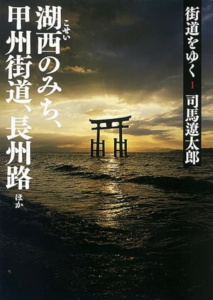Life Tips & Miscellaneous Travel and History Zen Philosophy and History Art and Sport Navigation of this blog
On the Road – Katsuragi Road
Travel is an act for human beings to visit new places and experience different cultures and histories. Through travel, people can actually feel historical events and people’s lives by visiting historical places and cultural heritage sites, and can gain a deeper understanding of history and broaden their own perspectives. In this section, we will discuss the historical background of the trip and the places visited based on Ryotaro Shiba’s “Kaido yuku” (On the Road) about this journey and history.

Kaidou wo yuku Vol 1 Katsuragi michi.
In the previous article , I described the Koushu Kaido. In this article, I will discuss the Kasturagi Road.
Katsuragi Road
The Katsuragi region is located southeast of the Nara Basin. While proceeding from Fuefuki-jinja Shrine, which enshrines Fuefuki-ren, the ancestor of the ancient Japanese clan Fuefukibu, to hitikotonusi-jinja Shrine, which enshrines the ancestor of the Katsuragi clan, hitokotonushi and Emperor Yuryaku, as well as En no Gyoja (Yaku Shokaku), who is said to be a member of the Kamo clan, the relationship between the ancient clans in Katsuragi and Japanese royal authority is described. The journey ends at Takagamo Shrine, which enshrines the ancestor of the Kamo clan.


The official name of Fuefuki-jinja Shrine will be Katsuragi za Hinaraijinsha. The shrine will be a shrine standing in a forest shrine enshrined by a family of an ancient dynasty that was in Katsuragi before the Yamato Imperial Court entered Nara. (Star on the above map)

The deity was the god of fire and thunder and the ancestor of the Fuefuki-ren, who was in charge of divination (the practice of burning animal bones and tree bark to determine good and bad fortune according to the cracks that appear on them). In Fuefuki-ren, they used to burn hahaka (Japanese cherry trees) in the forest.

Since the god is related to fire, a cannon from the Russo-Japanese War era is dedicated to the god, and the same characters as the “Fire and Thunder God” from the anime “Demon-Slayer” are written on the shrine’s name plate.

And in the southern direction, one can see Mt. Amanokagu, which is often sung about in the Manyoshu.

The story then turns to Emperor Yuryaku (the 21st emperor), who lived in Hatsuse (Sakurai City) in Yamato in the latter half of the 5th century, and the ancestor of the ancient clans of Katsuragi, the hitokotonushi no Kami. He had a quarrel with Emperor Yuryaku and was once exiled to Tokushima. 300 years later (764), thanks to a group called “Kamo” who lived at the foot of Mt. Katsuragi, he returned to Nara and the shrine was named “Hitotsukushi Shrine.

According to the Kojiki, Emperor Yuryaku was hunting on Mt. Katsuragi when a man with the same appearance and behavior came to him. When asked who he was, he replied, “I am the god of word separation, the great god of the Lord of One Word of Katsuragi, who does all evil things and all good things. It is said that this was the beginning of the Katsuragi Hitotsukunushi Shrine. hitokotonushi Shrine is also known as “Ichigon-san,” or “Ichigon-san,” and is one of the most famous power spots in the Kansai region, as it is said to grant one wish, whether bad or good.
The aforementioned Kamo clan is aloso famous for presence of Abe no Seimei, a famous yin-yang master, and En no Gyoja, also known as the founder of the ninja, as described in “Koga to Iga no Shigaraki no Michi” (On the Road to Shigaraki, Koga and Iga)

The journey then ends at the Takakamo Shrine (star below on map), which enshrines the ancestral god of the Kamo clan.

In the next article, we will discuss the Choshu Road.


コメント